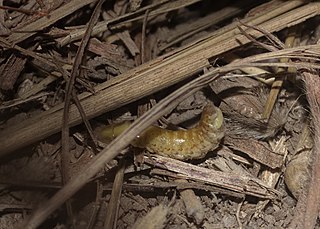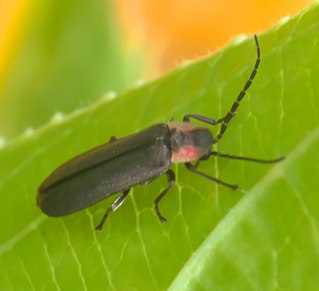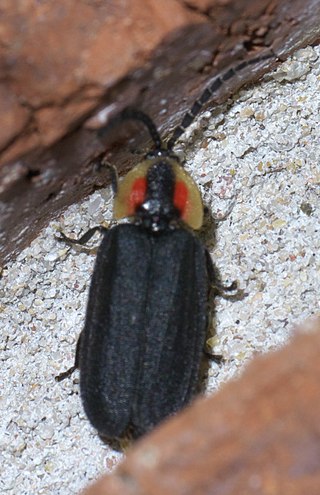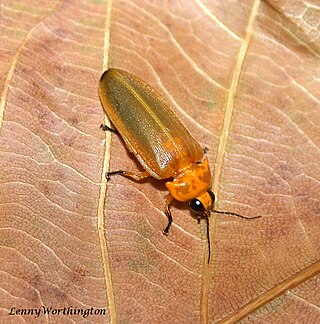Related Research Articles

The Lampyridae are a family of elateroid beetles with more than 2,000 described species, many of which are light-emitting. They are soft-bodied beetles commonly called fireflies, lightning bugs, or glowworms for their conspicuous production of light, mainly during twilight, to attract mates. Light production in the Lampyridae is thought to have originated as an honest warning signal that the larvae were distasteful; this was co-opted as a mating signal in the adults. In a further development, female fireflies of the genus Photuris mimic the flash pattern of Photinus species to trap their males as prey.

Photuris is a genus of fireflies. These are the femme fatale lightning bugs of North America. This common name refers to a behavior of the adult females of these predatory beetles; they engage in aggressive mimicry, imitating the light signals of other firefly species' females to attract, kill, and eat the males. Their flashing bioluminescent signals seem to have evolved independently and eventually adapted to those of their prey, mainly unrelated Lampyrinae, such as Photinus or Pyractomena.
Glowworm or glow-worm is the common name for various groups of insect larvae and adult larviform females that glow through bioluminescence. They include the European common glow-worm and other members of the Lampyridae, but bioluminescence also occurs in the families Elateridae, Phengodidae and Rhagophthalmidae among beetles; as well as members of the genera Arachnocampa, Keroplatus and Orfelia among keroplatid fungus gnats.

The Rhagophthalmidae are a family of beetles within the superfamily Elateroidea. Members of this beetle family have bioluminescent organs on the larvae, and sometimes adults, and are closely related to the Phengodidae, though historically they have been often treated as a subfamily of Lampyridae, or as related to that family. Some recent evidence suggested that they were the sister group to the Phengodidae, and somewhat distantly related to Lampyridae, whose sister taxon was Cantharidae, but more reliable genome-based phylogenetics placed as the sister group to the Lampyridae.
Brachylampis blaisdelli is a species of firefly in the family Lampyridae. It is found in North America.
Pleotomus nigripennis is a species of firefly in the family Lampyridae. It is found in North America.

Pyractomena is a genus of fireflies in the family Lampyridae. There are at least 20 described species in Pyractomena.
Brachylampis is a genus of fireflies in the family Lampyridae. There are at least two described species in Brachylampis.

Pleotomus is a genus of fireflies in the family Lampyridae. There are about five described species in Pleotomus.

Aspisoma ignitum is a species of firefly in the family Lampyridae. It is found in the Caribbean, Central America, North America, and South America. Its presence is uncertain in the United States.

Pyropyga is a genus of primarily North American fireflies in the beetle family Lampyridae. There are about 13 described species in Pyropyga. It is among the genera of Lampyridae where both sexes of adults have no bioluminescent organs.
Micronaspis is a genus of fireflies in the family of beetles known as Lampyridae, containing only one species, the Florida intertidal firefly. It is found in the Bahamas and Florida. It is threatened by habitat loss from coastal development as well as storm surges and sea level rise as a consequence of climate change, with Hurricane Dorian having a major impact on Grand Bahama island, where the species is known from. Increased chemical and light pollution has also seriously affected the species. Further threatening it in Florida is the introduction of Steinernema carpocapsae as a biocontrol agent for crops, which is known to target other beetle species than the ones it is meant to control; it is likely the cause of a local extirpation of a population of M. floridana from Sarasota Bay.

Lucidota is a genus of fireflies in the beetle family Lampyridae. There are more than 160 described species in Lucidota.
Prolutacea is a genus of fireflies in the family of beetles known as Lampyridae, containing a single described species, Prolutacea pulsator.
Tenaspis is a genus of fireflies in the beetle family Lampyridae. There are about 18 described species in Tenaspis.
Bicellonycha is a genus of fireflies in the beetle family Lampyridae. There are more than 40 described species in Bicellonycha.
Pterotus is a genus of fireflies in the beetle family Lampyridae. There are at least two described species in Pterotus.
Paraphausis is a genus of fireflies in the family of beetles known as Lampyridae, containing a single described species, Paraphausis eximius.
Pollaclasis is a genus of fireflies in the beetle family Lampyridae. There is one described species in Pollaclasis, P. bifaria. Pollaclasis is most closely related to Pterotus, and may someday become included within the Pterotinae subfamily.

Pteroptyx is a genus of fireflies in the subfamily Luciolinae found in Southeast Asia. It has long been noted for the ability to perform synchronous flashing, though not all species synchronize. These synchronizing species have been found on so-called 'firefly trees' and created a growing firefly-watching tour industry in some regions. Species of the genus have been identified in Malaysia, Thailand, the Philippines, and Hong Kong.
References
- ↑ "Nelsonphotus Report". Integrated Taxonomic Information System. Retrieved 2018-04-30.
- ↑ "Browse Nelsonphotus". Catalogue of Life. Retrieved 2018-04-30.
- ↑ "Nelsonphotus". GBIF. Retrieved 2018-04-30.
- ↑ "Nelsonphotus Genus Information". BugGuide.net. Retrieved 2018-04-30.